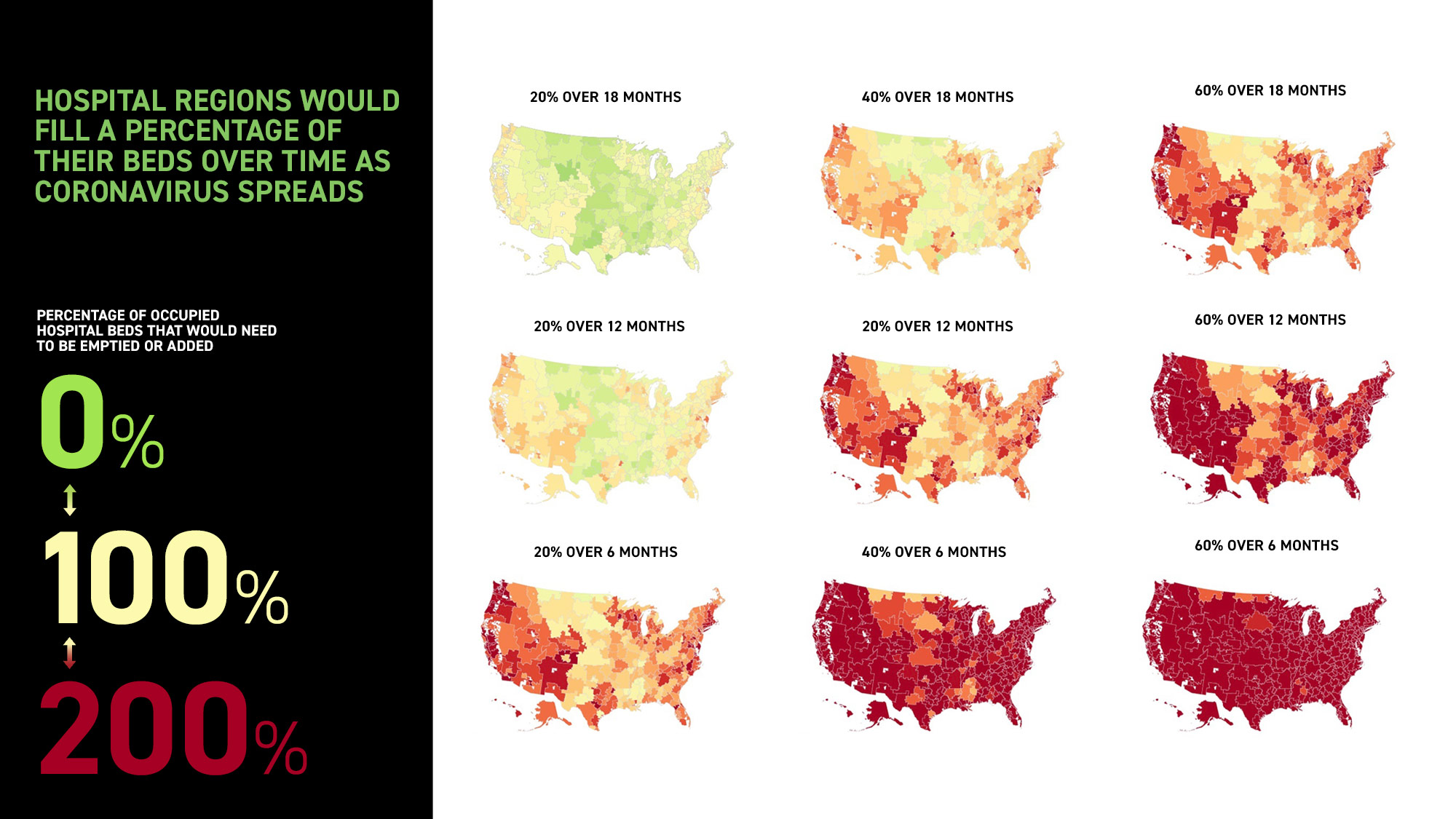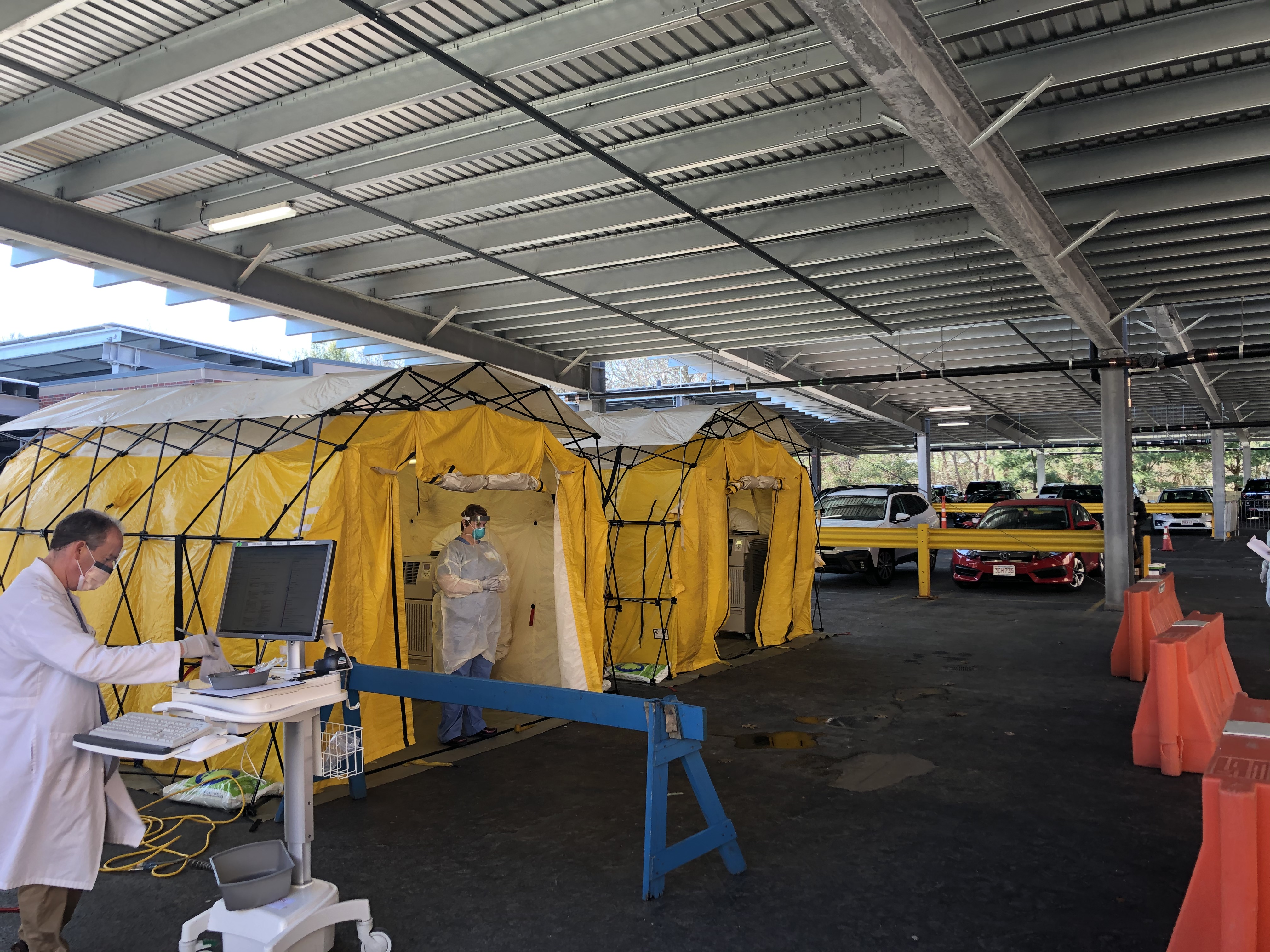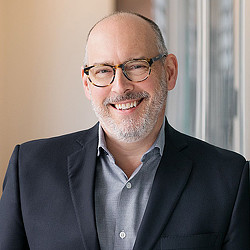Designing Healthcare for Surge Capacity
March 23, 2020 | By Randy Guillot, James Crispino, and Scot Latimer
Editor’s Note: This post is part of our ongoing exploration of how design is responding to the COVID-19 pandemic.
The healthcare system in the U.S. is undergoing considerable stress due to an influx of patients infected with the novel coronavirus. Hospitals are facing a potential shortage of beds, and many are already overwhelmed. Scenario modeling shows that even optimistic projections point to a shortfall of available beds by a significant factor if the new coronavirus continues to spread and hospitals don’t expand capacity. Ultimately, this worldwide event will forever change how we design healthcare spaces and places.
Because of this we believe more than ever that widely distributed health networks can change access to care and the shape of cities.
For years, the healthcare system in the U.S. has been focused on developing strategies and spaces that expand the reach and network of health systems in communities where people can connect and stay healthy outside of a hospital. This strategy has expanded care away from traditional hospitals and into the community in outpatient settings. For the most part, care is closer to home and more accessible; it puts a focus on wellness rather than acute care. It can also decrease the need for hospital beds, continuing a trend of the last few decades.
Therein lies our current dilemma. A lower cost and wellness-oriented system is what everyone wants in times when things are ‘normal.’ But the shift to distributed care doesn’t leave much room for a massive surge of sick people who need hospital beds and acute care. How can our system of care work better in a time of crisis? In times like these, we need strategies that can connect MORE people to hospitals and hospital beds.
Thinking creatively for surge capacityWe believe that part of the longer-term answer lies not just with traditional health providers, but in the potential of our cities and communities to adapt and change. They can offer flexibility for treatment when pandemics occur — to be a kind of bellows that can expand and contract when needed around different priorities for those seeking care.
In short, we need systems of both health and wellness that continue to give people more choice and we need those systems to flex and respond to pandemics like COVID-19. We need a system that is designed to accommodate a surge of capacity.

The building of temporary hospitals, as we have seen in China in a stunningly short period of time, was possible because of advance planning and preparedness measures and stockpiling of components for rapid assembly. On China’s retailing giant Alibaba’s website, you can even find for sale entire prefabricated hospital buildings.
Thinking creatively around increased space for surge capacity in close proximity to the medical facilities that provide the critical care resources is essential. The answer is likely not building bigger and more hospitals that might sit empty most of the time, but in an increased focus on flexibility and adaptability in our environments.
We believe that changing access to care can change the shape of cities for the better. The spaces and places that enrich our communities in times of health can often shift their focus in service of the common good in a crisis.
Here are a few possible solutions:
1. Repurposing existing facilities
Part of the solution may rest in things like the Navy hospital ships steaming towards the east and west coasts of the country to relieve the loads for non-COVID-19 related care. Meanwhile, states are looking to existing facilities that traditionally serve other functions — such as sports stadiums, convention centers, hotels, or student housing — that can also be rapidly repurposed to become isolation rooms, treatment bays, or serve other temporary, ad-hoc functions in time of need.
The changes in design of sports venues, in particular, with more locations near the urban cores of our communities have potential for repurposing if in proximity to medical centers and the patient populations they serve. Working together with our Sports, Education, and Health & Wellness practices, for example, we can reimagine how sports venues shuttered during the pandemic can operate with a second life as treatment facilities or vacant college dorm rooms can be converted to house patients (or healthcare staff) in a post-acute setting.
2. Rethinking the hospital
As we have grown outpatient networks across the country our acute care hospitals have run ‘hotter’ (i.e., at higher levels of occupancy) with a focus on caring for the sickest of the sick. In these times, the flexibility to adapt has become more elusive on acute campuses with needs for more specialized care spaces. In addition, non-clinical spaces have often been called into question. These ‘softer’ spaces — spaces capable of performing multiple functions easily — need to be thought about in ways that add value in crisis conditions from the start, so that our ‘bellows hospital’ is capable of expanding and contracting more easily.

3. Putting support spaces to work
We have seen examples in countries like Israel and China of facilities that can be converted quickly to everything from secure mass casualty facilities to infectious disease care sites in a matter of hours. As we have moved toward investing into outpatient sites of care in the U.S., our hospital cores need this same level of investment in preparedness and infrastructure. Our client at Newton-Wellesley Hospital in Boston, for example, has rapidly converted their parking structures to a testing site for the anticipated increase in screenings due to the coronavirus.
4. Reactivating former patient care spaces
The push over the years to update aging infrastructure and old hospital wings has created a generation of health campuses that have reused outdated patient care towers for administrative or other non-patient facing functions. These structures may still have valuable clinical adjacencies and links to critical elements on healthcare campuses in addition to potential negative air pressurization capabilities. The ability to reactivate these kinds of spaces in the event of events like COVID-19 can provide a much-needed relief valve during surging demand. As we explored in Gensler’s research study, The Hospital Left Behind, thinking creatively about legacy healthcare infrastructure offers opportunities to serve the community in good, as well as challenging times.
The move to outpatient care in many communities along with increased emphasis on preventative care, along with a focus on modular planning of exam rooms and staff areas, has created a ready-made chassis for breaking down the scale of populations for treatment during a viral outbreak. Clinical module-based designs like those at Cook County Health Central Campus Health Center or Rush University, if designed proactively, can provide surge capacity that is ready-made for the compartmentalization required for infectious populations.
6. Investing in caregiversWe will get through this challenging time. Ultimately, the rate limiting factor in all of this may not be the physical resources at all, but rather, the dedicated healthcare professionals who are required in each of these scenarios. Our healthcare workforce is aging and shrinking with retirements. Taking care of our healthcare providers at all points along the care continuum should be a top priority in any scenario going forward.
For any media inquiries, please email .


_1547667052_508x508_250x250.jpg)